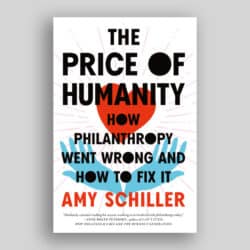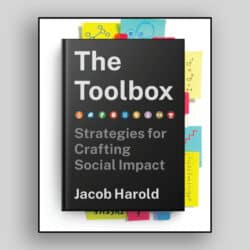By G. Newton and C Buda
Published by Centre for Community Ventures, Berkeley, CA. 1986
The Complete Guide to Money-Making Ventures for Nonprofit Organizations
By Peter C Brown
Published by The Taft Group, Washington, DC. 1986
Nonprofit Entrepreneur: Creating Ventures to Earn Income
Edited by Edward Skloot
Published by The Foundation Center, New York City. NY. 1988
Filthy Rich & Other Nonprofit Fantasies: Changing the Way Nonprofits Do Business in the ’90s
By Dr. Richard Steckel
Published by Ten Speed Press, Berkeley, CA. 1989
REVIEWED BY WILLIAM GLEBERZON
Executive Director, Meals on Wheels (Ontario) Inc.
It used to be pretty easy to define a not-for-profit organization. It used to be even easier to distinguish it from the for-profit organization. The points of distinction went beyond bottom-line considerations. They encompassed attitudes and perceptions which reflected life choices by those who toiled in each field.
But, it seems, the only constant is change.
Many charitable organizations, particularly in the cultural field (e.g., art galleries) and in the health field (e.g., hospitals) have been involved with “profit-making” activities for some time.The proceeds from these activities are ploughed back into the operation of the sponsoring facility. But as governments across North America cut back on their financial assistance to not-for-profit organizations, many other not-for-profits are considering a tum to nontraditional sources for funding, sources such as “profitmaking” enterprises. Moreover, the expectations ofboth the general public and the government for the services provided by the not-for-profit sector as well as the number of people requiring those services steadily increase.
So, what can be done?
Well, if you’re a Canadian, then you can look to your neighbours to the south for advice (just as they appear to be turning to a mutual neighbour in the east for guidance). Comparatively speaking, our American not-forprofit cousins have been responding to restricted government funding longer than we have. And they live in a society in which the profit drive has a stronger and more encompassing cultural impetus than in Canada. Of the many books the Canadian not-for-profit novice can turn to for advice on this issue, four recent publications are readily available (at the library of The Canadian Centre for Philanthropy). The four books are: G. Newton and C. Buda, Profit Making for Nonprofit Agencies; Peter C. Brown, The Complete Guide to Money-Making Ventures for Nonprofit Organizations; Edward Skloot (ed.), Nonprofit Entrepreneur: Creating Ventures
To Earn Income; and, Dr. Richard Steckel, Filthy Rich 4 Other Nonprofit Fantasies: Changing the Way Nonprofits Do Business in the ’90s.
Profit Making for Nonprofit Agencies . Newton and Buda’s book is printed (actually typewritten) and bound like a typical not-for-profit publication. It is folksy in design and orientation, a resource manual for those who want to explore the possibility of entering this unknown territory. Comprehensive and simple (but not simplistic), it is probably the sort of book on the subject that many volunteer agencies would find “comfortable”. Its 14 chapters-actually 13 chapters, since “there is no chapter 11 in this book!”, a sly reference to the American “Chapter Eleven” legal protection available to bankrupts-touch on subjects such as how to develop a business plan; examples of successful business ventures by not-for-profits; costing and pricing; product ideas; and, “look at your market”. As in all of these four books, the chapter on legalities and taxes requires Canadianization in its content but it is still an important warning about areas which require examination.
The Complete Guide to Money-Making Ventures for Nonprofit Organizations
Peter C. Brown’s book is somewhat slicker in presentation and format Designed as a workbook, its advice to the reader is “write in it, pull it apart, put it to work”.
The book developed from a study undertaken by Peter C. Brown Associates for the Twin Cities Regeneration Funding Project (Minneapolis and St. Paul, Minnesota). The purpose of the study was “to investigate the pros and cons of increasing earned income as a means of enhancing the financial stability of nonprofit agencies, and to learn what kinds of help nonprofits need to develop more earned income”. Beginning with the premise that “Making money is Okay (for nonprofits),” the book styles itself as a “self-help guide”. Accordingly, it was designed for agencies seeking a long-term strategy for raising revenues; for executive directors seeking an easy management guide; for boards and staff members seeking a working tool; for the “director of enterprise” seeking a day-to-day reference book and guide; and for others (e.g., funders like the United Way) who want a better understanding of the possibilities offered by profit-making enterprises. To meet this diverse market, the book includes advice on how to read the book itself by emphasizing that the reader should focus on the chapters on “Facilitating Working (Planning) Sessions”; “Getting Outside Help”; and, “Looking at One Idea to the Exclusion of Others”. All the chapters include action steps and work sheets.
Nonprofit Entrepreneur: Creating Ventures to Earn Income
Edward Skloot is the president of New Ventures, a New York-based consulting firm which specializes in advising nonprofit executives how to strengthen their organizations’ management, business and marketing functions. He has geared his book to nonprofit executives who want to familiarize themselves with the possibilities offered by “venturing” (Skloot’s buzz word for profit-making activity).
Comprising nine chapters written by experts (professors, consultants and lawyers), the book concludes with an annotated bibliography. According to Editor Skloot, “if one message underpins the book, it is that there is no substitute for good analysis and ongoing vigilance. Like any difficult activity, venturing has its own rules of success … ” Skloot’s book is more sophisticated and focused than the preceding two books. However, as it is written for the American market, Canadians must make the appropriate national (in regard to legal and taxation matters) adjustments. Skloot’s two essays on how to get started in venturing are particularly useful to the novice.
Filthy Rich & Other Nonprofit Fantasies: Changing the Way Nonprofits Do Business in the ’90s
Dr. Richard Steckel’s book is the most attractive of the four books in terms of its layout and presentation. The author’s goal is “to show … how the most successful nonprofits find the flow of enterprise by trusting their fantasies and borrowing tools from the private sector. (The book) will show you how successful nonprofits use enterprise to get their message heard, their mission met”
Empowering nonprofits to fantasize (Part One) about financial success, the author leads his readers over the same terrain as the other three books, but in a far more entertaining manner. The book is filled with snappy chapter titles such as, “What Light Through Yonder Nonprofit Breaks?”, the short concluding chapter; and, subheadings, such as “Virginity, Pollution & the Filthy Rich”, on the legitimacy of the use of the word “profit” rather than the euphemistic “excess over expenditures” usually found in nonprofit budgets. Part Two of the book presents case studies of nonprofits succeeding with enterprises. Part Three lays out techniques for “Creating the Fantasy”. Part Four demonstrates “Making the Fantasy Ready” through creating an enterprise by setting up and staffing a Department of Enterprise and Fundraising. The book concludes with an “Enterprise Workshop”, a worksheet which enables the reader to consolidate the ideas derived from the book. If readers have any problem completing the worksheet, the author advises them to get in touch with him for help. Dr. Steckel tosses down a provocative gauntlet to non profits by accusing them of being “distrustful of money”. Many of them, he says, reject the idea of”the bottom line”, equating that notion with the for-profit world. “They fear that if concerned with money, they will lose their social goals. They fear money will pollute their missions. They fear they will lose their nonprofit virginity…. Entrepreneurial nonprofits like money rather than fear it”
Obviously the authors of these four books have no such fears. Whether Steckel’s analysis is-or should be-correct is another matter. In any event, these four books provide the not-for-profit organization with the opportunity to explore the possibilities of engaging in enterprise or “venturing” as a potential and viable source of funding in a rational, comprehensive and entertaining manner. They even offer readers a rationale for changing the attitudes and perceptions which may have motivated their individual life choices.


